The Knitting version of the Sea Breeze Cover Up was more of a challenge for me as a knitter and I was thinking when first started to work on it that the pattern I had in mind will work or that I will never finish the dress. 😅 But everything worked so perfectly and it was so addictive and I can’t tell you enough the excitement I felt while working on it.
The idea was to recreate as much as possible the Sea Breeze Cover Up crocheted version and I think I manage to reach this goal pretty well. There are a few differences, as knitting is not crocheting, but I hope you will like it.
You can Purchase the easily printable PDF version of this pattern here:
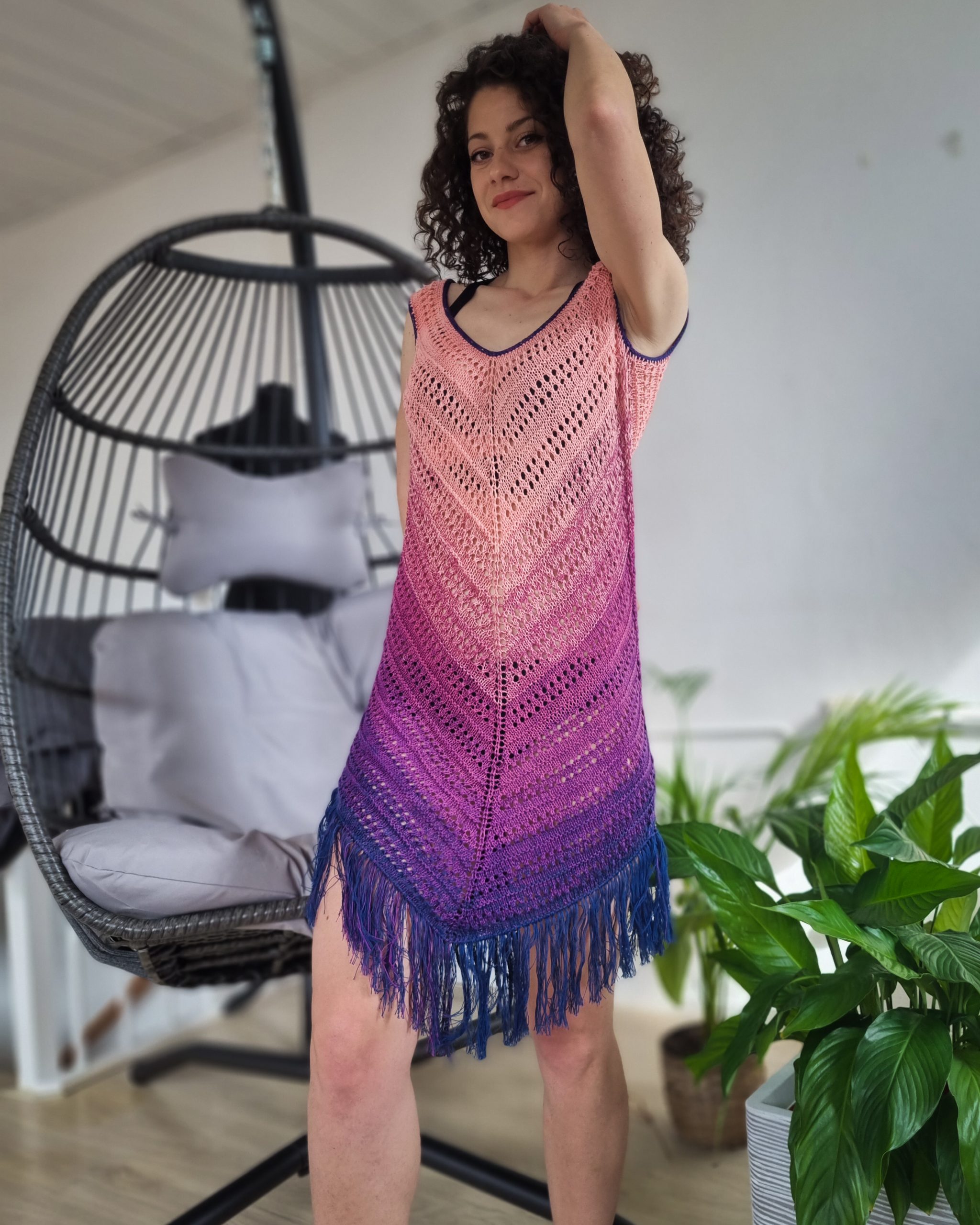
So let’s see how I made this Sea Breeze Cover-up Knitting Version and how you can make one.
MATERIALS
• Yarn: Size 1 or 2, Fingering or Sport Weight yarn
• Needles:
o *3.5 mm with a 100 cm cord
• yarn needle for weaving in ends
• Scissors
• stitch markers
*you will need 2 pairs to work for the front and back panel
NOTES ABOUT DESIGN
The Sea Breeze Cover-Up Dress has a top-down construction with a V pattern on the front and back panels. The dress is worked in the round, except when working front and back panels across the armholes.
The Sea Breeze Cover-Up Dress has a closer fit with no positive or negative ease.
MEASUREMENTS AND SIZES
The Sea Breeze Cover-Up Pattern is available in 9 sizes, from XS to 5X Large. The model is 168 cm tall, with an 86 cm Bust circumference, and wears a size XSmall.
The numbers are written below as follows: XS (S, M), (L, XL), (2XL, 3XL, 4XL, 5XL); US sizes 0/2 (4/6, 8/10), (12/14, 14/16W), (18/20W, 22/24W, 26/28W, 30/32W)
All the measurements use as reference Standard Body Measurements by ASTM International.

*Final Measurements of the Sea Breeze Cover-Up
Neck to Bust Center a:25cm (25, 26), (27, 28), (29, 31, 33, 36)
Armhole depth b: 12cm (13, 14), (16, 16), (22, 24, 27, 27)
Bust width c: 41cm (44, 46.5), (50, 53.5), (58.5, 63.5, 68.5, 73.5)
Length. d: 72cm (72, 72), (72, 72), (72, 72, 72, 72)
* Follow the instruction below if you want to adjust the pattern according to your measurements.
How much yarn do you need?
For the Sea Breeze Cover-Up I used:
Hobbii Azalea in Color Berry Rose (07). Yarn composition: 52% cotton, 48% acrylic. One cake has 200 grams and 800 meters.
For bigger sizes, you can use a solid color in the same shade as the cake’s beginning or end. For the color I used, one suggestion is Hobbii Twister Solid in color Dark Denim (126)
Other yarn suggestions: Hobbii Twister, Scheepjes Whirl
For each size you will need:
*720 (770, 810), (870, 930) ,(1020, 1110, 1190, 1280) meters
For sizes S, M L, XL, XXL, 3XL, and 4XL you can use 1 cake variegated yarn and one cake solid. For size 5XL you can use 2 cakes of variegated yarn
ABBREVIATIONS
co – cast on
k – knit
p – purl
yo – yarn over
k2tog – knit 2 sts together
St(s) – stitch(es)
R – rows
*, ** – repeated section.
TENSION
Using 3.5 mm needles in the main st pattern
19sts = 10 cm
14 rows = 4.5 cm (1 pattern repeat)
You can Purchase the easily printable PDF version of this pattern here:

STITCH PATTERN AND TECHNIQUES
The stitch pattern is created by alternating solid rows with eyelets rows
Solid Row: stockinette
eyelets row: *yo, k2tog
Pattern repeat:
R1 – R4: stockinette
R5: eyelets
R6 – R8: stockinette
R9: eyelet
R10 – R13 stockinette
R14 – garter
Rep. R1 – R14 as indicated
PATTERN NOTES
- work the first 4 rows in the round;
- work front and back panels, across the armholes flat; turn after each row
- when splitting for the armholes, use a second pair of needles if you work with variegated yarn; if not you can use an extra cable to put sts on hold
- when working the first 4 rounds, after each round you will have 4 sts more;
- when working front and back panels, after each row you will have 2 stitches more
- if you use a variegated yarn, work for the front and back panels alternatively, 14 rows on each;
- follow the instructions below if you want to make this dress to measure.
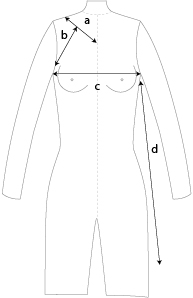
If the indicated measurements in this pattern don’t fit you, you can adjust this pattern according to your measurements and gauge.
Here is how:
Step 1: Make a gauge swatch and count the number of sts and rows you have in a 10/10 cm square
Step 2: Calculating the number of stitches to start with:
1. Measure Neck to Bust center length (a); Bust Center can be as high or low as you wish, depending on how deep you want the V Neck to be.
2. Multiply the result by 4; the result will be the starting circumference in measuring units;
3. Transform cm (inches) into stitches:
circ. in cm x number of sts from your gauge / 10 (this is your swatch width in cm)
4. Adjust the total number of stitches to match the stitch pattern requirements;
The eyelet pattern requires a multiple of 2+1 stitches.
so, the next result: (total number of sts – 2)/2, needs to be a multiple of 2+1.
Now that you have the number of stitches to start, you can follow the stitch pattern for the first 4 rows.
Step 3: Measure the armhole depth (b):
- the starting point should be perpendicular to the Neck to Bust center line; the endpoint should be at the middle of your armpit, with 2-3 cm below for comfortable wearing.
- use the first 4 rows you already worked as a reference, and use a stitch marker to mark the starting point
- mark the same number of sts on the left and right of the center point of your work
- measure bust width (c)
- transform length (b) into rows
- start working the armhole rows and keep measuring the bust width on your work.
- if after finishing the total number of rows, the bust width is too small, you can
1. either work a few more rows, or
2. increase also at the beginning and at the end of the row to add extra stitches
2. add extra armpit sts, when joining front and back panels, to work the trunk - measure the armpit length (d) and transform the length into rows (according to your gauge)
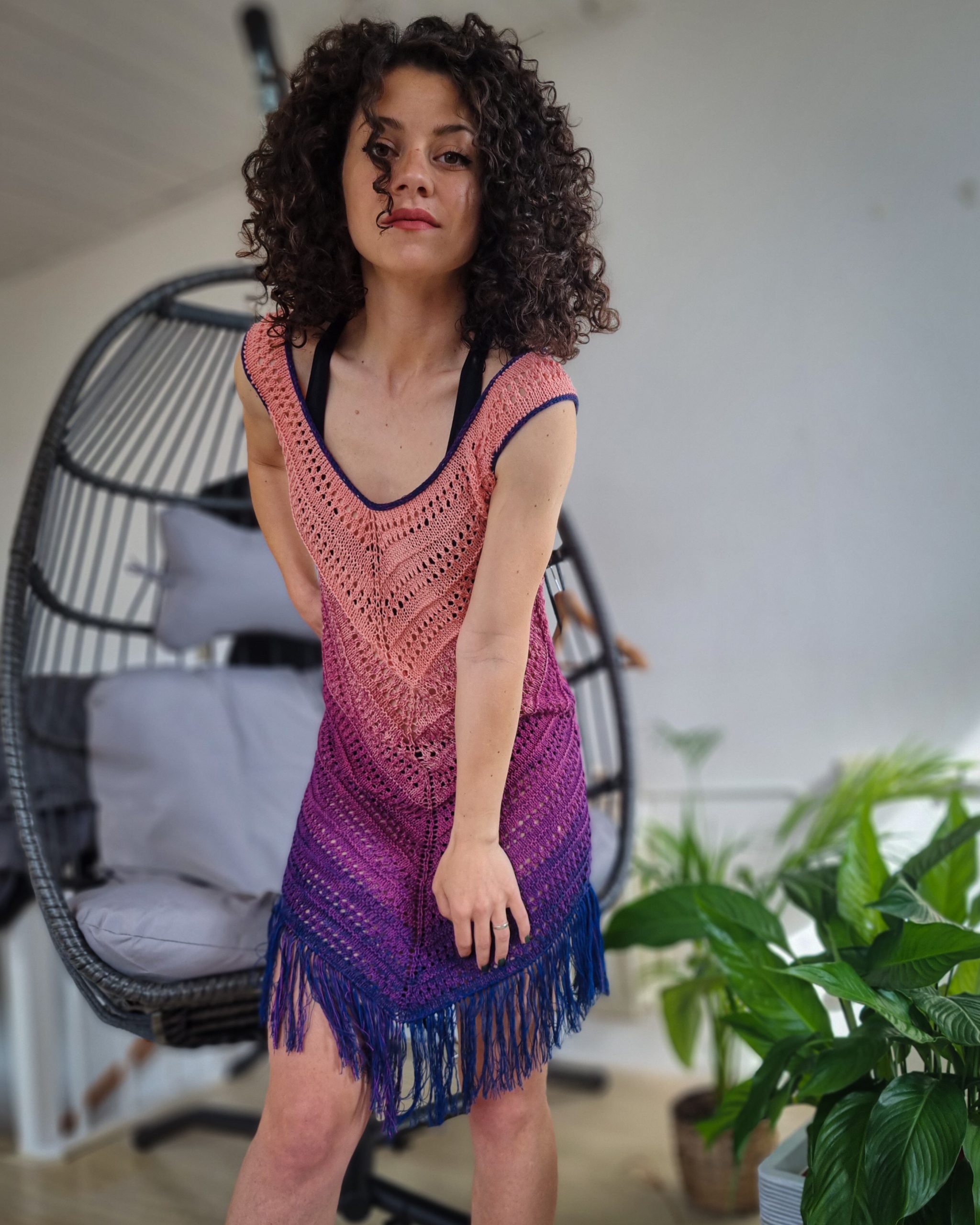
You can Purchase the easily printable PDF version of this pattern here:
INSTRUCTIONS
Start: co 192 (192, 196), (204, 212), (220, 236, 248, 272)
R1: k all sts
R2: continue in the round; place an st. marker before the first st
k1, place an st marker, k 95 (95, 97) (101, 105), (109, 117, 123, 135), place an st marker, k1, place an st marker, k all sts to the end of the row, 95 (95, 97) (101, 105), (109, 117, 123, 135) sts.
R3: k1, pass st. marker, yo, k all sts before the next st. marker, yo, pass st. marker, k1, pass the st, marker, yo, k all sts until the end of the row.
Total: 196 (196, 200), (208, 216), (224, 240, 252, 276)
R4: k all sts
R5: Rep. R3
Total: 200 (200, 204), (212, 220), (228, 244, 256, 280)
R6: Rep. R4
R7: k1, pass the st. marker, yo, *k2tog, yo; *rep until you have 1st left before the st. marker, k1, yo, pass the st marker, k1, pass the st. marker, yo, k1, **yo, k2tog; ** rep. until the st. marker, yo, pass the st. marker.
Total: 204 (204, 208), (216, 224), (232, 248, 260, 284)
R8: rep. R4
R9: Rep. R3
R10: Rep. R4
R11: Rep. R7
R12:Rep. R4
R13; Rep. R3
R14: Rep. R4
R15: Rep. R3
R16: p all sts
Total: 220 (220, 224), (232, 240), (248, 264, 276, 300)
Cut the yarn.
FRONT AND BACK PANELS
- work for front and back panels, across the armholes flat; turn after each row
- if you use a variegated yarn, work for the front and back panels alternatively, 14 rows on each;
- use stitch markers and mark the front and back panels stitches following the instructions below;
Count the sts for the back and front panel, from the st. markers that mark the center point, to the right and left.
37 (39, 41), (43, 45), (45, 47, 51, 57);
You will have in total for the front and back panels 75 (79, 83), (87, 91), (91, 95,103, 115) sts.
BACK PANEL
– Pass all the sts up to the second st marker, from right to left needle. (this will include, the sts for half back plus the sleeve sts.
– Use the second pair of needles; rejoin the yarn and bind off the sleeve sts.
R1: k all the sts up to the next st marker (the center point), yo, pass the st marker, k1, pass the st marker, yo, k all st up to the next st. marker. turn
Total: 77 (81, 85), (89, 93), (93, 97,105, 117) sts.
– use stoppers end let the rest of the sts on hold (second sleeve sts and front panel sts)
R2: p all sts
R3: rep. R1
Total: 79 (83, 87), (91, 95), (95, 99,107, 119) sts.
R4; rep. R2
R5: k1, *yo, k2tog; *rep. until you have l the st marker, yo, pass the st. marker, k1, pass the st. marker, yo, **k2tog, yo; ** rep. until you have 1 st left, k1
Total: 81 (85, 89), (93, 97), (97, 101,109, 121) sts.
R6: Rep R2
R7: Rep. R1
R8: Rep R2
R9: Rep. R5
R10: Rep. R2
R11: Rep. R1
R12: Rep. R2
R13: Rep. R1
R14: k all sts
Total: 89 (93, 97), (101, 105), (105, 109,117, 129) sts.
- if you are working with variegated yarn, cut the yarn and start working the first 14 rows on the front panel; you will start the same as with the back panel, by binding off the sleeve sts.
- if your color changed right when finishing the 14 rows set or closer, you can work another set on the same side
Next, rep. R1 to R14 until you will have in total: 36 (40, 44), (48, 50), (52, 52, 52, 52) sts.
For Sizes XS, S, M, L, and XL the BACK PANEL is done; move to the JOINING ROUND.
For Sizes 2XL, 3XL, 4XL, and 5XL you need to continue working 8 (12, 16, 16) rows more. On the increasing rows, you will also need to increase with 1st at the beginning and at the end of the row.
FRONT PANEL
Rep. the same pattern as for the BACK PANEL.
JOINING ROUND
After finishing the last row from the Front/Back Panel, turn and start the row as usual. After working the last st, continue with the sts of the other side (Back/Front Panel); place 1st markers, on each side, to mark the Front and Back Panel sts.
For sizes 2XL, 3XL, 4XL, and 5XL only, add 8 (12, 16, 16) sts at the armpit.
BODY
- continue working in the round;
- to keep the dress line straight, the sts added in the center points of the Back and Front panels will be subtracted on the sides;
- make the decreases on the rows without increases;
- the pattern for the body is written for the 14 rounds repeat; start the body with the following round in the pattern and repeat according to your size
R1: k all sts up to the next st marker, yo, pass the st. marker, k1, pass the next st marker, yo, k all the sts up to the next st marker (the side one) pass the st, marker, k all the sts up to the next st marker, yo, pass the st. marker, k1, pass the next st marker, yo, k all the st up to the end of the row, pass the last st marker
R2: k1, k2tog, k all the sts until you have 2sts left before the side st marker, k2tog, k1, pass the stitch marker, k1, k2tog, k all the sts until you have 3 sts left before the end of the row, k2tog, k1, pass the last st marker.
R3: rep. R1
R4: rep. R2
R5: [k1, *yo, k2tog; *rep, until the center point st marker, yo, pass the st marker, pass the next st marker, yo, **k2tog, yo; **rep until you have 1st left until the side st marker, k1, pass the st marker]; rep.
[ ] one more time until the end of the row.
R6: rep. R2
R7: Rep. R1
R8: Rep. R2
R9: Rep. R5
R10: rep. R2
R11: rep. R1
R12: rep. R2
R13: rep. R1
R14: k1, k2tog, p all the sts until you have 2sts left before the side st marker, k2tog, k1, pass the stitch marker, k1, k2tog, p all the sts until you have 3 sts left before the end of the row, k2tog, k1, pass the last st marker.
Next, Rep, R1 – R14 until you have the desired length or until you have 12 pattern repeats in total, for the entire dress.
Bind off
FINISHING
Neckline and armhole I-cord edging
Version 1
Step. 1: pick up the sts around; put on the needle, the middle bar of the row/stitch.
Step 2: On the right needle, cast on 3sts.
Step 3: pass the sts from the right needle to the left needle (the one that has the picked-up sts.
Step 4: k first 2 sts, k the next st together with the next st from the edge
Step 5: pass the sts from the right to left needle.
Rep. Steps 4 and 5 until you complete the entire circumference
Version 2
Step 1: cast on 3sts and pass them on the left needle
Step 2: k1, k2tog, k1 from the edge
Step 3: pass the sts from right to left needle.
Rep. Step 2 and 3 until you complete the entire circumference.
Fringe
Cut the yarn into strands of about 20 cm.
Fold one strand in half; use a crochet hook and insert the hook into the st, grab the loop of the folded strand and pass it through the st; take the ends and pass them through the loop and tie.
Repeat in every stitch.
Note: you can work with many strands at once and make the fringe thicker; if you prefer so, skip a few sts between the fringe.
You can Purchase the easily printable PDF version of this pattern here:

I am so happy with the result and I hope you will be too!
Until next time, Happy Knitting and Crocheting

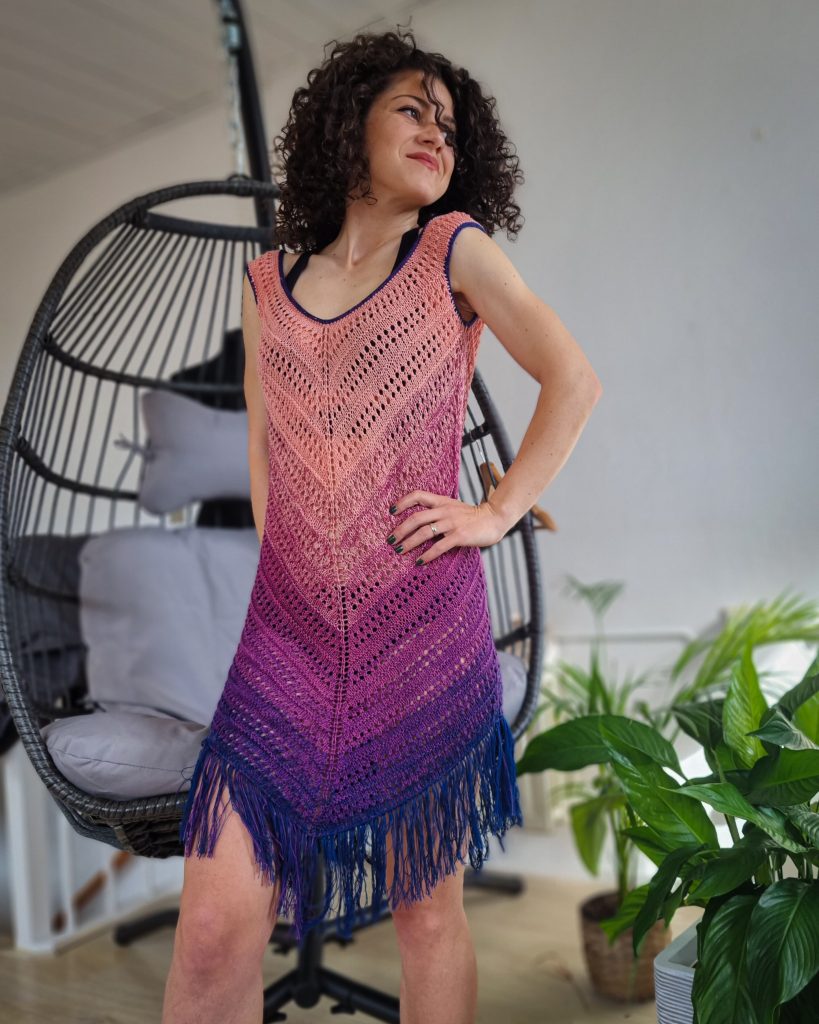



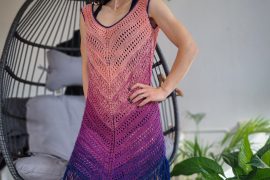
Comments are closed.